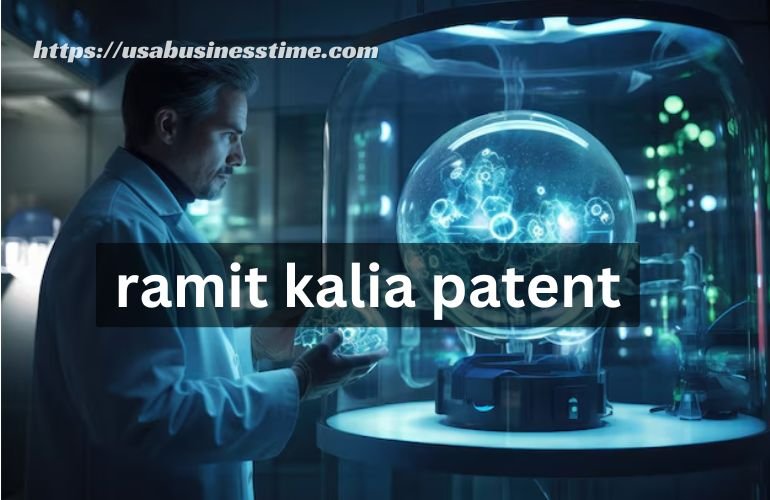Introduction
Ramit Kalia’s patent represents a significant advancement in technology, bringing operational efficiency and sustainability to industries such as healthcare, manufacturing, and technology. This patent stands out for its eco-friendly design, aligning with growing global demands for sustainable solutions. By prioritizing both performance and environmental impact, the patent promises to transform sectors that rely heavily on data processing and automation.
Table of Contents
Who is Ramit Kalia?
Ramit Kalia is a recognized expert known for contributions to engineering, automation, and technology innovation. His journey reflects a robust educational background and professional experience focused on advancing data-driven and automated systems. Kalia’s expertise spans several fields:
- Engineering and technological innovation.
- Automation solutions for complex systems.
- Sustainability-focused designs that cater to modern environmental needs.
Kalia’s background and industry experience make him a leader in developing solutions aimed at enhancing operational efficiency.
Overview of the Ramit Kalia Patent
Kalia’s patent focuses on optimizing data processing and automation, providing sustainable solutions for industries that rely on high-efficiency operations. This technology combines advanced algorithms and a user-friendly design to enable integration across existing systems while minimizing environmental impact.
Key elements of the patent include:
- Advanced Data Processing: Enhanced algorithms streamline data handling and analysis.
- Eco-friendly Design: The system requires less energy, aligning with sustainability goals.
- Scalable Functionality: The technology can adapt to varied operational requirements across sectors.
Significance of the Patent in Today’s Technology Landscape
In a world where efficient data and resource management are vital, Kalia’s patent addresses several contemporary challenges. Its innovative data processing and automation capabilities contribute to eco-friendly practices and streamlined resource usage.
Key aspects include:
- Data Processing Efficiency: The patent handles large volumes of data efficiently, essential in data-driven sectors.
- Sustainability: With reduced energy consumption, the patent contributes to environmental preservation, an increasingly critical goal for industries worldwide.
Core Features of the Patent
Several unique components define the impact of Kalia’s patent:
- Optimized Algorithms: High-level algorithms enhance data management.
- User-friendly Integration: Designed to be compatible with various systems, making it easy for organizations to adopt.
- Scalability: The technology’s flexibility enables its application across diverse sectors, from healthcare to manufacturing.
Industry Applications of Kalia’s Patent
The patent’s applications extend across numerous industries, demonstrating its versatility. Key sectors benefiting include:
- Healthcare: Enhanced diagnostics and reduced error rates.
- Manufacturing: Improved automation in production lines.
- Technology: Advanced data processing for tech solutions and innovations.
These examples underline the patent’s practical utility and efficiency in real-world settings.
Impact on Healthcare
In healthcare, Kalia’s patent offers notable improvements in efficiency and accuracy. By streamlining data analysis, the patent reduces error rates and supports better patient outcomes.
Benefits include:
- Diagnostic Precision: Improved diagnostic tools aid in accurate medical assessments.
- Error Reduction: Automation minimizes human error, contributing to patient safety.
- Operational Efficiency: Faster data handling optimizes healthcare workflows.
Revolutionizing Manufacturing Processes
Kalia’s patent also makes significant strides in manufacturing by integrating automation into production lines, enhancing overall productivity.
Key advancements:
- Automation: Automated systems reduce manual intervention and enhance production speed.
- Efficiency Improvements: Manufacturers benefit from optimized operations, leading to cost savings.
- Case Studies: Early adopters report increased output and reduced error rates.
Advancements in Data Management and AI
The patent’s focus on data management and artificial intelligence contributes to streamlined operations in sectors reliant on large data sets.
Highlights:
- Data Set Optimization: The technology handles extensive data volumes without compromising speed.
- Real-time Analysis: AI-driven analysis supports quick decision-making in complex environments.
These advancements empower industries to leverage AI and data more effectively.
Sustainability and Environmental Impact
Kalia’s patent is environmentally conscious, offering energy-saving benefits that align with sustainable development goals.

Environmental benefits:
- Reduced Energy Consumption: The system is designed to minimize power usage.
- Contribution to Sustainability Goals: Eco-friendly practices help industries meet regulatory requirements.
This focus on sustainability underscores the patent’s relevance in today’s environmentally aware markets.
The Importance of Patents in Innovation
Patents are essential for protecting innovative ideas and encouraging creativity. Kalia’s patent showcases how intellectual property safeguards technological advancements, allowing inventors to contribute meaningfully to industry development.
Significance:
- Idea Protection: Patents prevent unauthorized use of innovations.
- Encouragement for Future Innovation: Protecting ideas promotes continued research and development.
Patents thus serve as vital tools for technological growth.
Success Stories of Patent Adoption
Businesses that have adopted Kalia’s patent report substantial improvements in productivity and operational efficiency. The healthcare and manufacturing sectors, in particular, have witnessed considerable advancements.
Examples:
- Healthcare Providers: Enhanced diagnostic accuracy and reduced operational errors.
- Manufacturers: Increased production speed and minimized waste, leading to cost savings.
These success stories highlight the patent’s real-world effectiveness and appeal across industries.
Challenges Faced in Patent Development and Implementation
Developing and implementing patents like Kalia’s is not without challenges, including legal and regulatory hurdles that affect adoption rates.
Challenges:
- Regulatory Compliance: Ensuring that the patent meets industry-specific regulations.
- Adaptation: Some sectors may face initial challenges in integrating new technology.
Despite these challenges, Kalia’s patent has overcome significant barriers to deliver effective solutions.
Future Prospects for Kalia’s Patent
Looking ahead, Kalia’s patent has the potential to expand across additional sectors, including renewable energy and global tech solutions. As industries continue to adopt eco-friendly practices, Kalia’s technology could play an even more prominent role.
Prospects:
- Renewable Energy Applications: Potential for integration into energy-efficient solutions.
- Global Expansion: Plans for international licensing support further adoption.
This growth highlights the long-term relevance and adaptability of Kalia’s invention.
How to Integrate Kalia’s Patent into Your Business
Companies looking to incorporate Kalia’s patent can follow several steps to ensure a seamless transition, focusing on relevant operational areas and employee training.
Steps:
- Identify Key Areas: Assess which departments could benefit most from the patent.
- Training Programs: Equip teams with the necessary skills for efficient implementation.
- Resource Allocation: Ensure that the required resources are available for a smooth integration.
These steps facilitate the adoption of Kalia’s patent, allowing businesses to capitalize on its advantages.
Frequently Asked Questions
1. What industries benefit most from the Ramit Kalia patent?
Industries including healthcare, manufacturing, and tech gain considerable advantages from Kalia’s patent due to its adaptability and efficiency.
2. How does the Ramit Kalia patent support sustainability?
The patent’s low energy consumption and eco-friendly design contribute to sustainability goals.
3. What makes Ramit Kalia’s patent unique
This patent’s combination of innovative algorithms, usability, and environmental consideration distinguishes it from others in the field.
Conclusion
Ramit Kalia’s patent exemplifies innovation that meets modern industry needs while maintaining a focus on sustainability. By addressing pressing challenges in data processing and automation, the patent has proven beneficial across sectors and promises continued impact in the future. As industries seek efficient and eco-friendly solutions, Kalia’s contributions stand as a testament to the potential of thoughtful, purpose-driven innovation.











